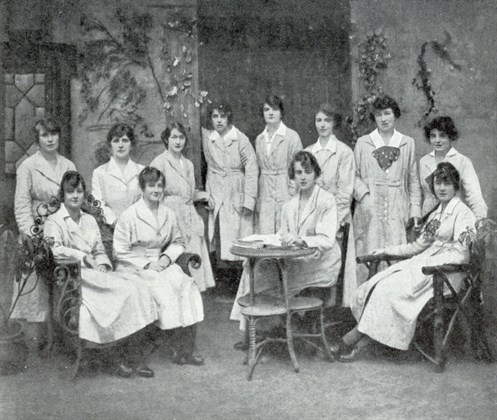
During the first half of the 19th century the insurance office was an almost-exclusively male territory, but there are a few accounts of widows who carried on running family businesses after the death of their husbands. The earliest known female agent was Ms Barnes who, in 1822, was appointed by the Norwich Union Life Insurance Society to take over her late husband’s business. Such women were extraordinarily rare exceptions – and unfortunately their stories went largely undocumented.
Chronicles of women’s work during that period are scarce for several reasons. Women’s work was difficult to classify and was not regarded as important enough to record, especially when this involved home-working or helping in a family-run business. Women may have also preferred to keep their earnings secret from their husbands – let’s not forget that, until the introduction of the Married Women’s Property Act of 1870, any money earned by a woman automatically became the property of her husband.
After 1941 professions were included in the Census, allowing us to glean a better picture of female employment. It was a time when public discussion of women’s work was proliferating and the government was beginning to legislate about certain aspects of women’s working conditions. By then industrialisation was widespread and, as a result, commercial activity soared, creating larger companies who in turn produced ever-larger heaps of paperwork to process.
Women provided a cheap and flexible workforce to the expanding insurance business – and were considered temperamentally better suited than men to undertake dull tasks. Their entry into the insurance office environment was not motivated by the goodwill of their male counterparts. Female clerks were employed as cheap labour to undertake routine tasks in response to the demands of expanding businesses. It was widely assumed that women were innately better suited to repetitive work – “such work as copying out policies, which could be done almost if not quite as well by girls as by men, and what is still more important in these days of small dividends, at a considerable reduction of costs” (Liverpool clerk’s journal, 1888).
I was the Prudential which opened the path to women’s work in insurance. As early as 1855 it employed women as ‘canvassers’, who pushed working-class housewives into taking life cover – once potential business was identified, they would pass it on to the agent and would keep a commission. Interestingly they were not allowed to work on Saturday, probably because their husbands were home.
The Prudential employed the first female clerks at the end of 1871. Others followed, all specialising in ‘industrial insurance’, another by-product of the Industrial Revolution, which gave life cover for weekly wages. Having to deal with small and numerous sums, these companies were forced to economise in staff costs earlier than others.
Technical advances such as telegraphs, typewriters and card indexes also required extra hands to operate them. The feminisation of the office was encouraged by the mass adoption of the ‘shift-key’ typewriter during the 1890s, which was easier to operate than previous models. Female typists, who were themselves referred to as ‘lady type-writers’, began to substitute male operators in insurance companies. In 1900, the Yorkshire in Glasgow, the Friends Provident and the Thames & Mersey in Liverpool employed their first female typists. Companies in London followed.
Qualifications were important in the selection process, but almost as important was that applicants “must all be the daughters of professional men” (The Office magazine, 1890). They were generally young middle-class women who could afford to take on poorly-paid jobs and expensive training. Subsequently business colleges flourished, often run by women entrepreneurs, who offered tuition in shorthand, typewriting and book-keeping. However, women faced discouragement to advance their formal insurance studies until 1919, when the CII lifted the bar on women sitting exams.
Business growth and technical innovations played a decisive role in the employment of women in the 19th century. The numbers speak for themselves: in the 1851 census, nineteen women were listed as commercial clerks; by 1891 there were 17,859.
References
- A Sense of Security: 150 Years of the Prudential, Laurie Dennett, London: Granta Editions, 1998
- The White Blouse Revolution: Female Office Workers Since 1870, Gregory Anderson (ed.), Manchester: Manchester University Press, 1989
- Women in England 1769–1914: a Social History, Susie Steinbach, Phoenix, 2005
- ‘Women in Insurance and in the CII’, CII permanent files, London: CII, 1960s
- ‘Women in Insurance’, Hugh Cockerell in CII Journal, London: CII, 1980
- ‘Women’s Work’, Professor Pat Hudson, BBC website, accessible via www.bbc.co.uk/history/british/victorians/womens_work_01.shtml

